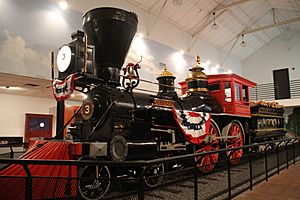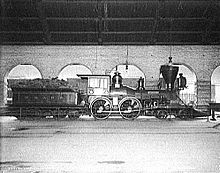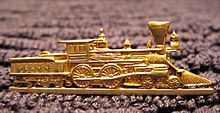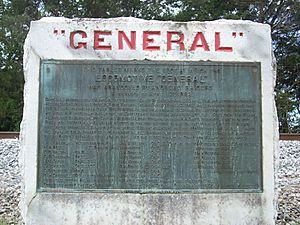The General (locomotive) facts for kids
Quick facts for kids The General |
|
 |
|
| The General on display in Kennesaw, Georgia, in 2007 | |
| Power type | Steam |
|---|---|
| Builder | Rogers, Ketchum & Grosvenor |
| Serial number | 631 |
| Build date | December 1855 |
| Configuration | 4-4-0 |
| Gauge | Originally 5 ft (1,524 mm), regauged to 4 ft 8 1⁄2 in (1,435 mm) in 1886 |
| Driver diameter | 60 in (1,524 mm) |
| Weight on drivers | 32,000 lb (15,000 kilograms; 15 tonnes) |
| Locomotive weight | 50,300 lb (22,800 kilograms; 22.8 tonnes) |
| Boiler pressure | 140 lbf/in2 (965 kPa) |
| Cylinders | Two, outside |
| Cylinder size | 15 in (381 mm) |
| Official name | General |
| First run | January 1856 |
| Retired | 1891 |
|
The General
|
|
| Location | Kennesaw, GA |
| Built | 1855 |
| Architect | Rogers, Ketchum & Grosvenor |
| NRHP reference No. | 73000617 |
| Added to NRHP | June 19, 1973 |
| Current owner | Southern Museum of Civil War and Locomotive History |
| Disposition | static display |
The Western & Atlantic Railroad #3 General is a famous steam locomotive built in 1855. It's known for being stolen by Union spies during the American Civil War. This event, called the Great Locomotive Chase, was an attempt to damage the Confederate rail system. Today, The General is kept at the Southern Museum of Civil War and Locomotive History in Kennesaw, Georgia. It is also listed on the National Register of Historic Places because of its historical importance.
Contents
Early Days of The General
The General was built in 1855 by a company called Rogers, Ketchum & Grosvenor in Paterson, New Jersey. Before the Civil War, this steam engine carried goods and passengers. It traveled between Atlanta, Georgia, and Chattanooga, Tennessee. It was part of the Western and Atlantic Railroad.
The General in the Civil War
On April 12, 1862, during the Civil War, The General was taken by Northern spies. Their leader was James J. Andrews. They stole the train at Big Shanty, which is now Kennesaw, Georgia. The spies were chased by another train, the Texas, driven by William Allen Fuller.
The General eventually ran low on water and wood, which made it lose steam and slow down. The spies had to abandon the locomotive about two miles north of Ringgold. Andrews and his group tried to escape on foot.
In 1864, during the Battle of Atlanta, Confederate General John Bell Hood ordered the destruction of military supplies. He also had The General badly damaged. The engine was crashed into boxcars full of ammunition and another locomotive. This was done on purpose to make sure the approaching Union forces could not use the train.
After the War: Back in Service
Some people thought the Union army fixed and used The General after it was damaged. However, many historians believe the engine was left alone for the rest of the war. The Union army had its repair shops in Nashville and didn't need to fix captured trains. They often left damaged equipment as it was. Records show The General was "captured and returned," suggesting it wasn't used by the Union.
After the war, The General was repaired and went back to work for the Western and Atlantic Railroad. In the 1870s, the train was completely rebuilt. It got a new front part, a new boiler, and other pieces. Its three domes were changed to two. Also, its special balloon-shaped smokestack was replaced with a diamond stack. This was because the engine was changed to burn coal instead of wood. After this rebuild, the engine looked very different from its original design.
Before the Civil War, most trains in the South, including The General, didn't have numbers. They only had names. After the war, the railroad started numbering its engines. The General was the 39th engine the railroad owned, so it was numbered "39." As years passed, new trains came and old ones left. By 1880, the trains needed to be renumbered. The General was then given the number "3" because it was the third oldest engine the railroad still had. It still carries this number today.
In the mid-1880s, the Atlanta and Florida Railroad began building its tracks. The Western and Atlantic Railroad had too many trains at this time. So, they rented The General to the A&F from 1887 to 1888 to help with construction.
The locomotive was first built to fit a wider track size, common in the Southern states. This was a 5-foot wide track. By June 1, 1886, all tracks were required to change to the U.S. Standard Gauge. This meant The General was changed to fit the narrower 4-foot, 8.5-inch track size.
Retirement and Public Display
The General stopped regular service in 1891. It was stored on a side track in Vinings, Georgia. The next year, a photographer named E. Warren Clark found the engine. He suggested restoring The General to display it at the World's Columbian Exposition in Chicago. The president of the Nashville, Chattanooga and St. Louis Railway (which now managed the Western and Atlantic) liked the idea.
The General was taken to the NC&StL Ry Shops to be restored. It was given a smokestack similar to its original one. It was also changed back to burn wood. By 1892, the engine was restored. It even traveled to Chattanooga for a reunion of Civil War veterans. This trip showed that burning wood was difficult. So, by the end of the year, the engine was changed back to burn coal. It got a unique new smokestack that looked like the original but was made for coal.
In 1901, The General was put on display at the Chattanooga Union Depot. It stayed there for almost 50 years. It was only moved for short times to be shown at special events. For example, it went to Baltimore in 1927 for the "Fair of the Iron Horse". It also went to Chicago's "Century of Progress" in 1933, the 1939 New York World's Fair, and the Chicago Railroad Fair in 1948.
In 1957, the Louisville and Nashville Railroad took over the Nashville, Chattanooga and St. Louis. They began planning to make The General run again for the 100th anniversary of the Civil War. In 1959, The General was moved from Chattanooga to the railroad's shops in Louisville for restoration. During this work, The General got modern air brakes and a modern coupler on its back (the front still had the old-style coupler). It was also changed to burn oil. Throughout the 1960s, the engine traveled around the eastern U.S., pulling a special car. It even went to the 1964 New York World's Fair using its own power.
Who Owns The General?
In the mid-1960s, the state of Georgia wanted to get The General back. Many ideas had come up since the 1930s about where to display it. These included places like Underground Atlanta, Kennesaw Mountain, or Stone Mountain Park. Even the city of Paterson, New Jersey, where the locomotive was built, wanted it. They had built many engines but had none to show. Paterson later decided to look for other engines.
Georgia's interest in The General caused problems with the city of Chattanooga, where the train was displayed. In 1967, the city of Kennesaw, where the engine was stolen, asked to have it for a fundraiser. The General was on its way there when a group led by Chattanooga's mayor, Ralph H. Kelley, stopped it. He believed the engine belonged to Chattanooga. A lawsuit was filed against the L&N railroad about who owned the engine.
On January 4, 1969, Judge Frank W. Wilson ruled that the engine belonged to the L&N. The city of Chattanooga appealed this decision. The case went to the U.S. Court of Appeals, which agreed with Judge Wilson. Chattanooga appealed one more time to the Supreme Court of the United States. The Supreme Court dismissed Chattanooga's appeal, meaning Judge Wilson's ruling was final. During this time, The General was stored in Louisville. It was only shown publicly for one weekend in November 1971 at the city's Union Station.
The General Today
After the L&N won the legal fight in 1970, they brought The General to Atlanta. They took a route that avoided Chattanooga. In February 1972, a ceremony was held in Atlanta. L&N president Kendall officially gave The General to the state governor, Jimmy Carter, who later became President of the United States.
Afterward, the engine was moved to Kennesaw, where a museum was being prepared. On April 12, 1972, the Big Shanty Museum opened. It is now known as the Southern Museum of Civil War and Locomotive History. The General has been on display there ever since.
Images for kids
See also
 In Spanish: La General (locomotora) para niños
In Spanish: La General (locomotora) para niños









